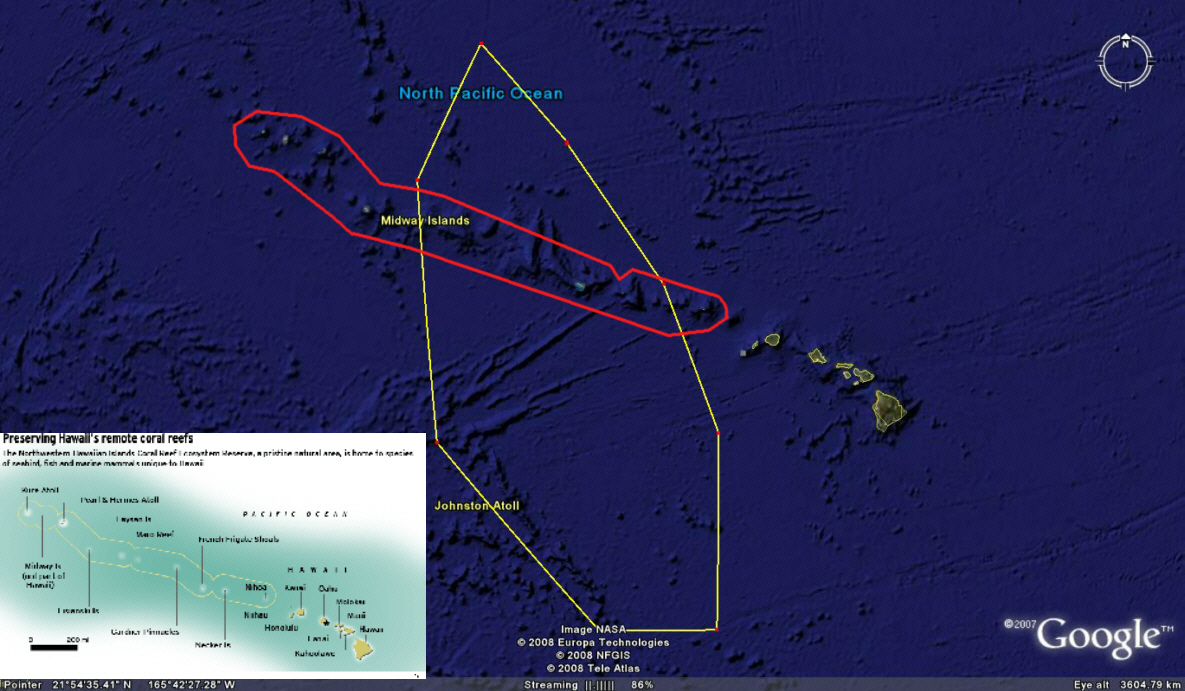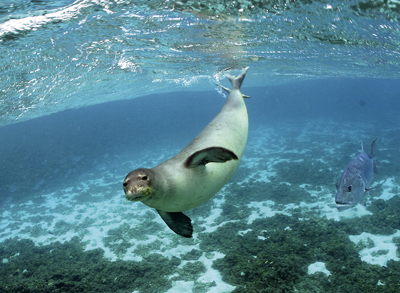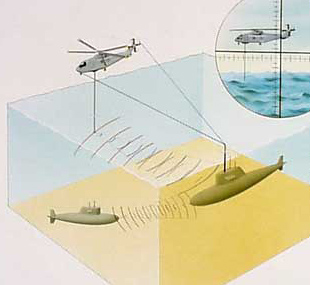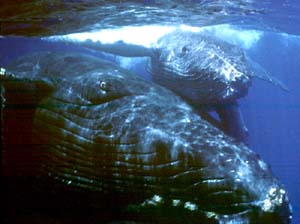Blog
News, updates, finds, stories, and tidbits from staff and community members at KAHEA. Got something to share? Email us at: kahea-alliance@hawaii.rr.com.
this gorilla is at least 800 pounds.
Amid the newspaper headlines shouting “SUCCESS” over the missile interception of a faltering US spy satellite in the “middle of the Pacific,” we received the following email from Greenpeace guys. They echoed our concerns about the potential of toxics and debris in the Northwestern Hawaiian Islands:
(from Martini Gotjé, former crew of the GP vessel Rainbow Warrior)
Here are the coordinates of the maritime warning for this sat to be shoot down by Aegis
NAVAREA XII 52/2008(19,83). NORTH PACIFIC. HAWAII. HAZARDOUS OPERATIONS.
1. HAZARDOUS OPERATIONS 210230Z TO 210500Z FEB, ALTERNATE
220230Z TO 220500Z, 230230Z TO 230500Z, 240230Z TO 240500Z
AND 250230Z TO 250500Z FEB IN AREA BOUND BY
31-45N 170-12W, 28-24N 166-42W,
23-52N 163-17W, 19-09N 161-29W,
12-41N 161-29W, 12-39N 165-32W,
18-42N 170-57W, 20-31N 172-30W,
27-03N 172-06W.
2. CANCEL THIS MSG 250600Z FEB.Note that the marine reserve in the NW Hawaiian Island is for a large part covered by this warning area
The toxic hydrazine what the military is talking about is then of no concern for US DoD to land in a reserve with threatened ocean life!!!!!!
See http://www.globalsecurity.org/space/systems/e-305.htm for the real reason why they want to shoot it down. It’s all secret and new technology and they want to make sure that no one can lay their hands on any piece.
He rightly points out that what we’re really talking about is the impacts and implications of expanding militarization of places–of our oceans, of space.
From an article in yesterday’s Hartfort Courant:
“But even as debris from the shattered satellite began raining down over the Pacific Ocean, there were worries that the U.S. achievement might spur other nations to advance their own anti-satellite programs and turn outer space into a potential battlefield.”
And from an article in today’s Australia’s Hearald Sun:
General Cartwright said radar imagery indicated the SM-3 missile hit the satellite’s fuel tank and obliterated the toxic fuel.
“From the standpoint of ‘can I rule out that hazardous material will fall to the Earth?’, not at this point.
This is occurring in a year of Naval training range expansion, undersea warfare exercises, and expanded 2008 RIMPAC wargames. It is also the International Year of the Reef. We’re talking a lot this year about marine debris, overfishing, and ocean acidification and reef death from climate change and warming oceans. Important, for sure.
But can we in Hawaii–currently the most heavily militarized of the 50 states–really talk about healthy reefs and ocean protection without tackling the question of ever-expanding military activities in Hawaiian waters?
Whether we are actively consenting or not, the train is moving. To do nothing is to move with it. We have a limited amount of time to decide–and to act–on the appropriate and humane global uses of lands, ocean, air, and space. At KAHEA, this is another year of doing. We hope you’ll join us.
(map from John Hocevar, missile photo DoD, and monk seal photo credit: James Watt)
counting all the pieces
From Miwa:

Marti, baby, and me–made the trek today to Oahu’s Windward side for B.E.A.C.H‘s clean-up of Laie Beach. This rural beach was littered with all varieties of plastic debris, and about 35 volunteers were there to pick it up and try to count it. Hundreds of bottle caps, plastic nets, and plastic refuse, washed up from all over the world. Years and years of plastic debris.
Plastic takes hundreds (possibly thousands) of years to biodegrade–what it DOES do is break into smaller and smaller pieces over time. In addition to the ancient toothbrushes, lighters, food wrappers, plastic pens, and styrofoam takeout containers, we found a beach littered with a confetti of small plastic bits.
I talked to a man who said he has lived on Laie for over 30 years–he was out on the stretch of beach beside us with a leafblower. A regular task, he says, trying to blow the plastic bits mauka, up off the beach. He talked about how he has seen the plastic problem get worse over the years. I asked him about the future, and he said he envisions his beach eventually “covered in a layer of colorful plastic grains, floating above the heavier sand and collecting a layer of algae slime.”

We finished our clean up a few hours later, and I felt a pang of sadness, looking at the result. More trash will wash in to replace what we cleaned. And even the many pounds we had piled into trash bags, was simply going off to a landfill. We can move it around as much as we want–but the plastic we create today is with us forever.
When we eat our lunch from a styrofoam box, it should make us think a bit: something with a useful life of minutes (okay, maybe a few days) will exist in our world–where we play and swim and hike and live–forever. Our great-great-great-great grandchildren will share the world with our old styrofoam cup. Along with the other 25 billion that we throw away each year.
We can do better. Hawaii is the final destination for a lot of the world’s plastic rubbish, washed up here by Pacific currents. Even in the remote and uninhabited Northwestern Hawaiian Hawaiian islands, plastic trash–marine debris–is a problem.
Happily, a few of our electeds are listening and we have a few opportunities this year to stand up here and show the world it can be done. This is historic, progressive stuff. And if we don’t, who will?
One current proposal to ban styrofoam takeout containers in Hawaii in 2010. To learn more and to support SB2495 and HB2495, go to www.stopstyrofoamhawaii.org. The word from those folks is that SB2495 has a second hearing scheduled for 2/14 and desperately needs to be heard to get out of committee! Send in those letters!
Navy Ordered to Establish Sonar-free Zones
Via Diana LeBetz on Kauai, excepts from a SF Chronicle article:
Wednesday, February 6, 2008
(02-06) 19:27 PST San Francisco — For the second time this week, a federal court found today that a Navy anti-submarine training program threatened to subject whales and other sea creatures to harmful blasts of sonar and ordered protective measures in several sensitive zones, including one near Monterey Bay.
The ruling by U.S. Magistrate Elizabeth Laporte of San Francisco applies to the Navy’s use of low-frequency sonar in submarine detection exercises conducted in large areas of the world’s oceans. She said Navy officials, who had agreed to restrictions after she issued a similar ruling in 2002, failed to take adequate precautions when seeking a five-year renewal of the program last year.
In its plans to shut off the sonar when whales and other vulnerable creatures are spotted, the Navy is relying on visual monitoring, which is unreliable, and on sonar detection, which is limited in range and may miss dolphins and other small animals, Laporte said.
“Marine mammals, many of whom depend on sensitive hearing for essential activities like finding food and mates and avoiding predators, will at a minimum be harassed by the extremely loud and far-traveling (low-frequency) sonar,” the magistrate said.
She said the Navy must establish sonar-free zones around several areas where sensitive marine life is plentiful, including the Davidson Seamount, which adjoins the Monterey Bay National Marine Sanctuary; the Galapagos Islands, 0ffshore from Ecuador; the Great Barrier Reef off Australia; the Pelagos, in the Mediterranean Sea, and a protected area of coral reefs and underwater habitat 115 miles northwest of the Hawaiian islands.
Link to full article by Bob Egelko of the San Francisco Chronicle.
activism and internet
In this week’s Honolulu Weekly, Ian Lind’s Honolulu Diary has a brief outline of some of the tools available to citizen activists for keeping up with state decision-making–everything from members of the Legislature to individual Commissions and Boards. Resources include the state calendar at www.hawaii.gov. And the campaign spending records at www.hawaii.gov/campaign/.
He also points out numerous problems:
“A check of the calendar last weekend listed meetings of the Land Use Commission on Maui on Thursday and Friday, February 7-8, with an agenda that included an item with staff recommendations regarding LUC’s position on land use bills pending at the Legislature. A quick check of the LUC’s own website, initially to see if more information about the agenda items might be available, turned up a notice that the Maui meetings have been canceled. Other agency meetings, such as the Board of Land and Natural Resources, are missing from the central calendar, and with well over 100 state boards and commissions, it’s difficult to know whether agencies ignore the main calendar or provide only the minimum six day notice required by law.”
The end result being, it seems to us, that while more information than ever is available via the internet to individual citizens, the system of posting and providing information on the web has a ways to go before it really meets its potential for making decision-making at the capitol truly accessible to the public it serves.
Hawaii Blue Line Project Rally at Stadium Park
from Marion Ano, KAHEA 2008 Graduate Intern:
The afternoon sun cast a warm glow throughout Stadium Park last week Wednesday on the corner of Isenberg and King. I attended the “Blue Line Project” Demonstration to build awareness of climate change, global warming, and to break the silence about sea level rise.
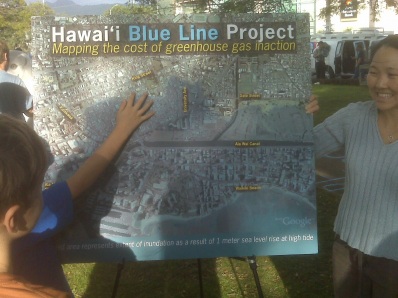
Each participant contributed their own message to Hawai’i. I enjoyed seeing children with their blue chalks in their hands and exchanging in the higher consciousness of the event. A blue line drawn seven blocks from Stadium Park proved to be the boldest statement of the demonstration. Onlookers stopped us and asked questions like “What are you doing?”. We responded by saying that sea level would inevitably rise to this blue line within 50 to 100 years. Unfortunately, no onlookers felt compelled to join in and be a part of this effort.
As I reflect upon the demonstration and the success of the event it is important for all of us to ponder and think of ways to continue building on this momentum. How can we effectively reach out to people and inspire change in the face of an inevitable doom?
One way or another each of us will contribute some effect on global warming. The choice is ours whether that effect will continue to be rapid and unforgiving or slow and responsible. The dialogue must continue before we find ourselves knee deep in water. Nature will no longer allow us to ignore it. Global warming has leaked past the walls of academia and eats away at our existing shorelines.
A fisherman on Moloka’i told me how much land he has lost due to sea level rise and he has done everything to curb the process. But, he knows that nature will win. Besides warmer temperatures and sea level rise, Hawaiian cultural practices could be lost forever. With rising sea levels comes the death of the coral reefs, and the ecosystems that its supports. Our native limu remains threatened by the invasion of non-native species. Furthermore, sea level rise will destroy their habitats and possibly cause remaining limu populations to dwindle.
The bottom line, the blue line that is will cost us more than money. There are some things that money cannot buy. Take responsibility because each of us has that power.
link to Honolulu Advertiser article on the demonstration
link to Sierra Club website find photos and press release
Congressman Urges Federal Investigation of Wespac
The Chair of the Committee on Oversight and Government Reform, U.S. Congressman Henry Waxman, called for an investigation by the GAO (Government Accountability Office) on Monday, in response to calls of concern from Hawaii NGOs regarding improper use of government funds and unethical conduct by Wespac (Western Pacific Fishery Management Council) and its Executive Director, Kitty Simonds.
Hawaii groups have been calling for an investigation for more than four years. Allegations have included altering of data pertaining to the Northwestern Hawaiian Islands, misuse of coral reef conservation money used to promote expanded commercial exploitation in the sensitive, fragile, and strongly protected Northwestern Hawaiian Islands (NWHI), use of Coral Reef Conservation Act funds to promote recreational fishing near Nihoa, an island in the NWHI which is home to important cultural sites, and improper use of federal money for lobbying efforts.
“These are serious allegations, and we look forward to the results of a thorough investigation. Wespac must be held accountable for the way it has been spending public money in its attempts to weaken protections for the Northwestern Hawaiian Islands,” said Vicky Holt-Takamine, Board President of KAHEA: The Hawaiian-Environmental Alliance. “Full protection of our natural and cultural resources demands prosecution of any such violations to the fullest extent of the law.”
Wespac is also under investigation by the Department of Commerce Inspector General (IG).
Federal Judge Rules Navy Sonar Must Comply with Environmental Laws
Woke up yesterday to the news, scrolling across the bottom of the TV screen, that President Bush’s recent action (NEPA exemption) to allow of the Navy to conduct nearshore sonar and anti-submarine warfare exercises is NOT legal and will not stand.
According the decision by a U.S. District Court Judge, the Navy is not exempted from compliance with the National Environmental Policy Act (NEPA) and must honor a court injunction creatng a 12 nautical-mile no-sonar zone off Southern California
From the article in Feb 5 Star Bulletin:
“It’s an excellent decision,” said Joel Reynolds, attorney for the Natural Resources Defense Council, which is spearheading the legal fight. “It reinstates the proper balance between national security and environmental protection.”
In May 2007, Earthjustice, along with KAHEA and several other local and national organizations, sued the Navy for their current Undersea Warfare Exercises (USWEX), which include a dozen high-intensity active sonar training events in the waters around Hawaii.
(photo from hawaiireef.noaa.gov)

